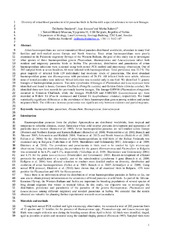| dc.description.abstract | Avian haemosporidians are vector-transmitted blood parasites that are distributed worldwide, abundant in many bird families and well studied across Europe and North America. Since avian haemosporidians have been poorly examined in the Palearctic migratory flyways of the Western Balkans, the goal of this study was to investigate which species of three haemosporidian genera, Plasmodium, Haemoproteus and Leucocytozoon, infect both resident and migratory passerines in Serbia. The prevalence, distribution and parasitaemia of avian haemosporidian infections were screened using both a nested PCR method and microscopy. Out of 202 birds sampled at seven localities, 66 were infected with haemosporidians, and the total prevalence was 32.7%. The great majority of infected birds (29 individuals) had moderate levels of parasitaemia. The most abundant
haemosporidian genus was Haemoproteus at 26.1% prevalence. All infected birds were adults; none of the tested juveniles were infected. Mixed infection was only recorded in one bird. We identified 31 genetic lineages of haemosporidians. Two new cytochrome b lineages, of Plasmodium and Leucocytozoon, were identified and found in the hosts Common Chaffinch
(Fringilla coelebs) and Golden Oriole (Oriolus oriolus), respectively. We identified three new host records for previously known lineages. The lineage GRW06 (Plasmodium elongatum) occurred in Common Chaffinch, while the lineages PARUS20 and PARUS25 (Leucocytozoon sp.) were recorded in Willow Tit (Poecile montanus) and Crested Tit (Lophophanes cristatus), respectively. We found statistically significant differences in the prevalence of three haemosporidian genera among residents and partial migrants. The difference in mean parasitaemia was significant only between residents and partial migrants. | sr |

